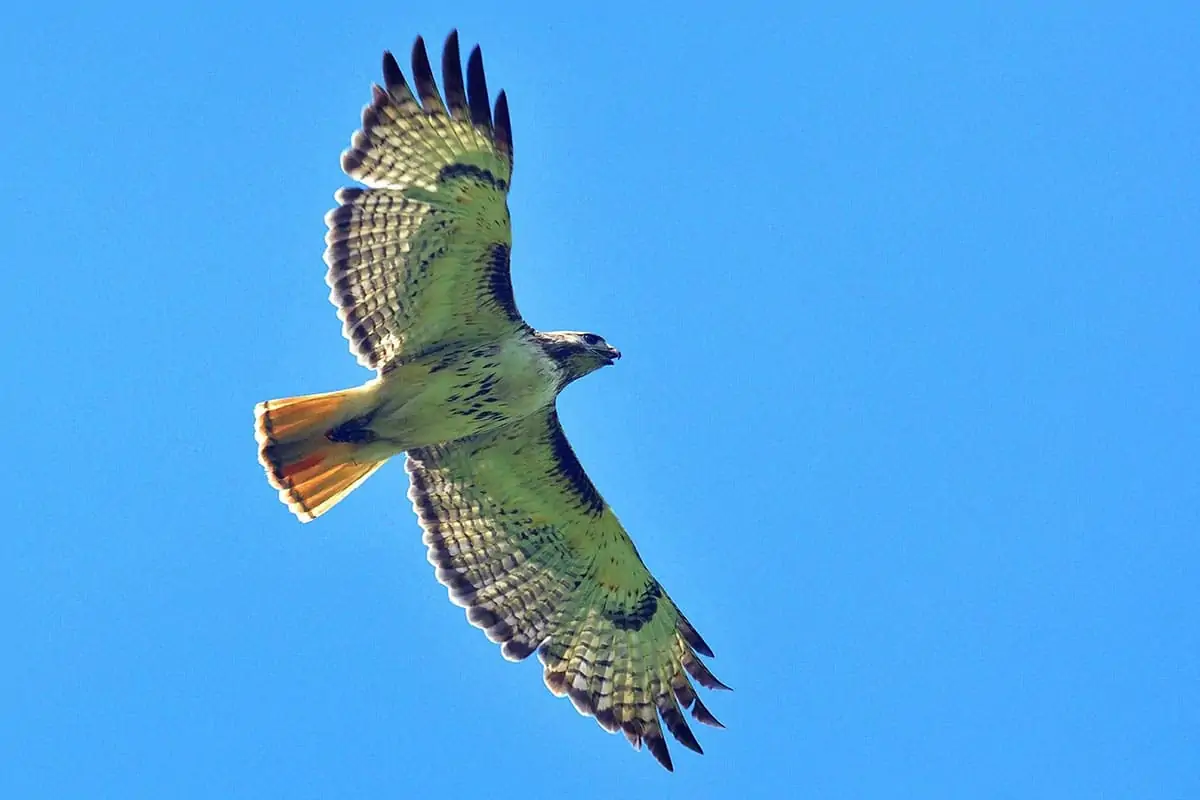The predatory family of hunting birds we call “birds-of-prey” includes hawks. Their keen hearing and sight, as well as their razor-sharp beak and talons, all come together to make them exceptional predators. Throughout the United States, there are roughly 16 different kinds of hawks. But, we’ll look at the six different types of hawks found in Mississippi, as well as one more bird that looks a bit like a hawk.
6 HAWKS IN MISSISSIPPI
The broad-winged hawk, Coopers hawk, northern harrier, red-tailed hawk, red-shouldered hawk, and sharp-shinnedhawk are the six types of hawks that may be found in Mississippi.
Let’s take a look at each one.
1. BROAD-WINGED HAWK
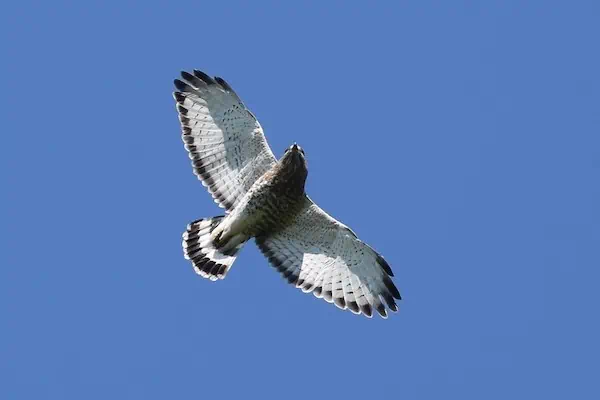
Scientific name: Buteo platypterus
Length: 13.4-17.3 in
Weight: 9.3-19.8 oz
Wingspan: 31.9-39.4 in
Only during the spring-summer breeding season do broad-winged hawks migrate north into Mississippi. The head and neck of these smaller hawks are brown, with barred underparts and black and white bands on the tail. The short tail and broad wings with pointed tips are easy to see in flight.
During the breeding season, these hawks prefer to stay away from prying eyes. Far from humans, they’ll nest in woodlands and near bodies of water. Little mammals, insects, and amphibians like frogs and toads are among the animals they eat.
Your greatest opportunity to observe the broad-winged hawk is during their return to South America in the fall. Millions of birds circle in the sky in flocks known as “kettles.” You may observe them in woodlands if you are not in their migration path. Hear the shrill whistles of these birds.
2. COOPERS HAWK

Scientific name: Accipiter cooperii
Length: 14.6 – 17.7 in
Weight: 7.8 – 24.0 oz
Wingspan: 24.4-35.4 in
Cooper’s hawks may be found practically across the whole of North America, with the exception of Mississippi, where they live year-round. The back of adults is blue, the chest is orange, and the eye is red. The head is squared off and capped with a black hat. A yellow eye, a brown back and head, and white underparts with hefty brown streaks characterize immature birds.
They may be found in woods and woodlands, but they are also quite located in the suburbs. Little birds are their primary food source, and they hunt them expertly in the tree canopy. The Cooper’s hawk is frequently seen in the backyards of many people, where it has been known to attack birds on a bird feeder, especially starlings, doves, and pigeons.
Studies of Cooper’s hawk skeletons reveal that many of them had broken bones in their chest, and Cooper crashed through trees and foliage on a high-speed chase after birds.
3. NORTHERN HARRIER

Scientific name: Circus hudsonius
Length: 18.1-19.7 in
Weight: 10.6-26.5 oz
Wingspan: 40.2-46.5 in
The face of the northern harrier is nearly owl-like. This disc-shaped face, like that of an owl, directs sound into the ears of these creatures so that they may hunt by sound and sight. Their lengthy tail and white patch above it are two helpful identifying characteristics. Their wings are held in a “V” formation, which is their customary flying style. These birds are majestic, as described by the term “majestic.”
The northern harrier will travel south to Mississippi in the winter months after spending the summer breeding in Canada and northern U.S. They’re often found in marshes, fields, and other wide-open places.
In dense vegetation like reeds, willows, sedges, and cattails, unlike many hawks that nest in trees, this hawk builds a platform on the ground. Males may have two (sometimes more) females at the same time, and both females and offspring will be fed by them.
4. RED TAILED HAWK
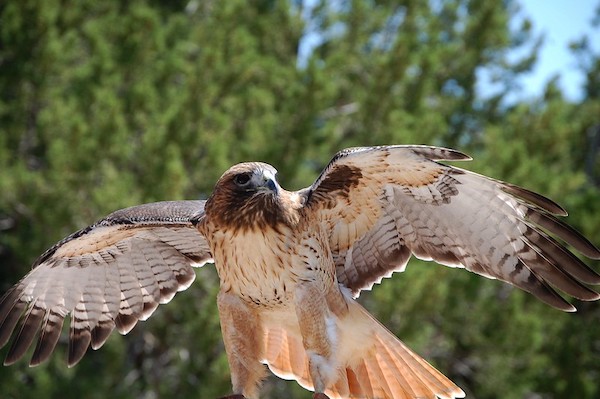
Scientific name: Buteo jamaicensis
Length: 17.7 – 25.6 in
Weight: 24.3oz – 51.5 oz
Wingspan: 44.9-52.4 in
The most prevalent hawk on the continent of North America, red-tailed hawks may be found in practically every state, including Mississippi. As birds that have spent their summer in Canada come down to join the others in the United States, their population increases even more during the winter.
Red-tailed hawks are most prevalent flying around in search of food, perched along the roadside on telephone poles, or at other times during the day or early morning. Little to medium-sized mammals, such as mice, rats, rabbits, and squirrels, make up the majority of their diet. Birds and snakes are also possible snacks.
The tail of an adult is brick-red, whereas that of a juvenile is brown and white striped. It’s simple to spot. These hawks have a light below and dark brown above, in general. Their breast is streaked with brown, and they have a band of darker brown streaks that runs across their belly region, which is another distinguishing feature. There are various color variations across the country since these hawks are so common.
A long scream emitted by the red-tailed hawk has become a symbol for all raptors. Their scream is typically employed as the sound for any hawk or eagle that appears on film or television.
5. RED-SHOULDERED HAWK
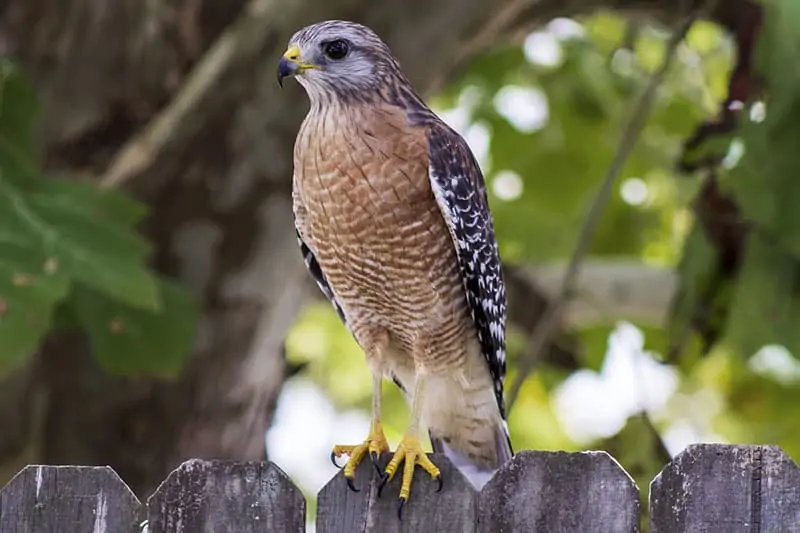
Scientific name: Buteo lineatus
Length: 16.9-24.0 in
Weight: 17.1-27.3 oz
Wingspan: 37.0-43.7
The eastern United States is home to a population of red-shouldered hawks. California’s western shore, as well as Japan’s. They are year-round residents in Mississippi.
The heavy red coloring on the breast, which extends all the way down their belly and is bordered by red, is a helpful identifying feature. Their back and wings are covered in dark, almost black feathers. This will be combined with reddish feathers (hence the name) at the top of their back and shoulders. A lot of white barring will be mixed in with the black feathers from the mid-back down, and a strongly banded tail will finish it off.
Before you spot the hawk, you may hear it. They emit a loud “kee-aah” call that is often repeated multiple times in a row. Others believe it resembles the cry of a seagull. When startled, they’ll scream to establish their territory.
These birds hunt in the woods, preferring flooded areas and wetlands over other habitats. In addition, in suburban environments with mixed woodlands and structures, they may be found. They are sometimes mistaken for red-tailed hawks, but understanding the distinctions is easier once you know them.
6. SHARP SHINNED HAWKS

Scientific name: Accipiter striatus
Length: 9.4-13.4 in
Weight: 3.1-7.7 oz
Wingspan: 16.9-22.1 in
The tiniest hawk in the US is a sharp-shinned hawk. In northern Mississippi, they may stay all year, but for the most part, they are only winter residents of the state. Little birds and rodents are eaten by these hawks while they fly through the woods.
Because they stick to woods with thick canopy while nesting, it’s difficult to locate them. They’ll go to bird feeders in the backyard on occasion. During fall migration, however, is the best time to see them. They go south, towards the United States. They are frequently seen at hawk watch sites from their summer habitat in Canada.
Sharp-shinned Hawks’ cream-colored chests and dark tail have blue-gray backs with reddish-orange barring. They have a more rounded skull and squared-off tail, much like the cooper’s hawk.
BONUS BIRD – THE OSPREY
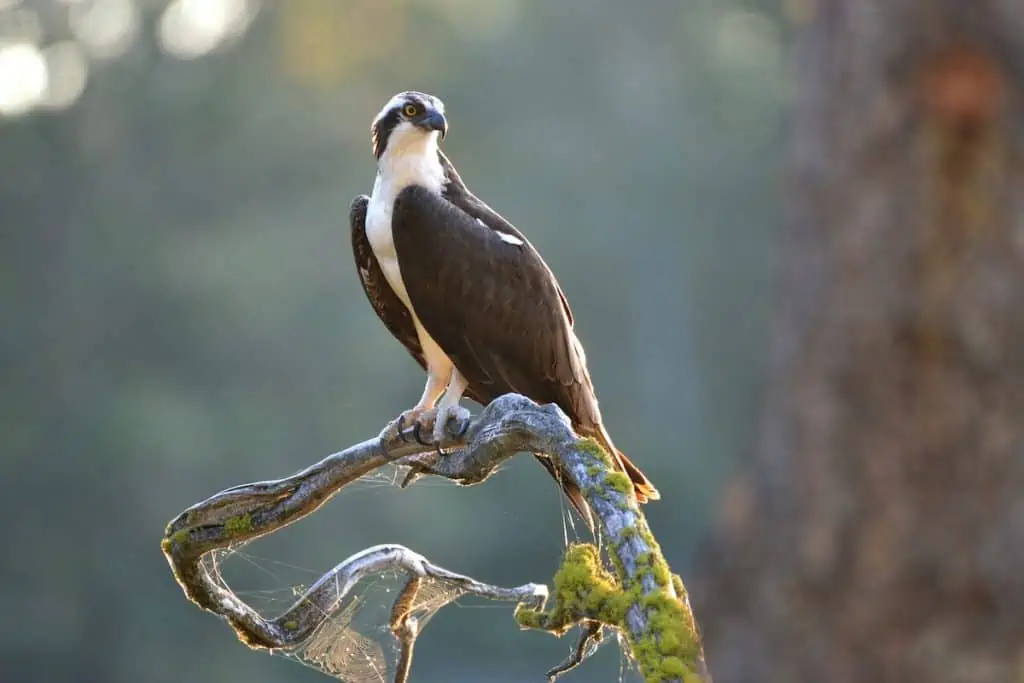
Scientific name: Pandion haliaetus
Length: 21.3-22.8 in
Weight: 49.4-70.5 oz
Wingspan: 59.1-70.9 in
They appear to be hawks and are genetically distant enough that they are classified as such, but ospreys are physiologically distinct. Because osprey solely eats fish, you will only see this raptor if you are near water. They can grip forward or backward with their outer toes. The slippery fish they catch is handled much better as a result of this adaptation.
During the summer, Ospreys are found in Mississippi. Any shallow, fish-laden bodies of water, such as lakes, rivers, reservoirs, and marshes will do. Hawks have a hard time distinguishing these birds due to their coloring. They have a hooked beak and a white head with a big dark brown stripe over each eye. From above, they look dark brown with pure white underparts. They have a dark brown patch at the “wrist,” which appears speckled while they’re flying.
Ospreys may utilize human-built platforms as well as treetop and cliff nests. To help conserve the osprey, many states put up osprey platforms along rivers and lakes.
